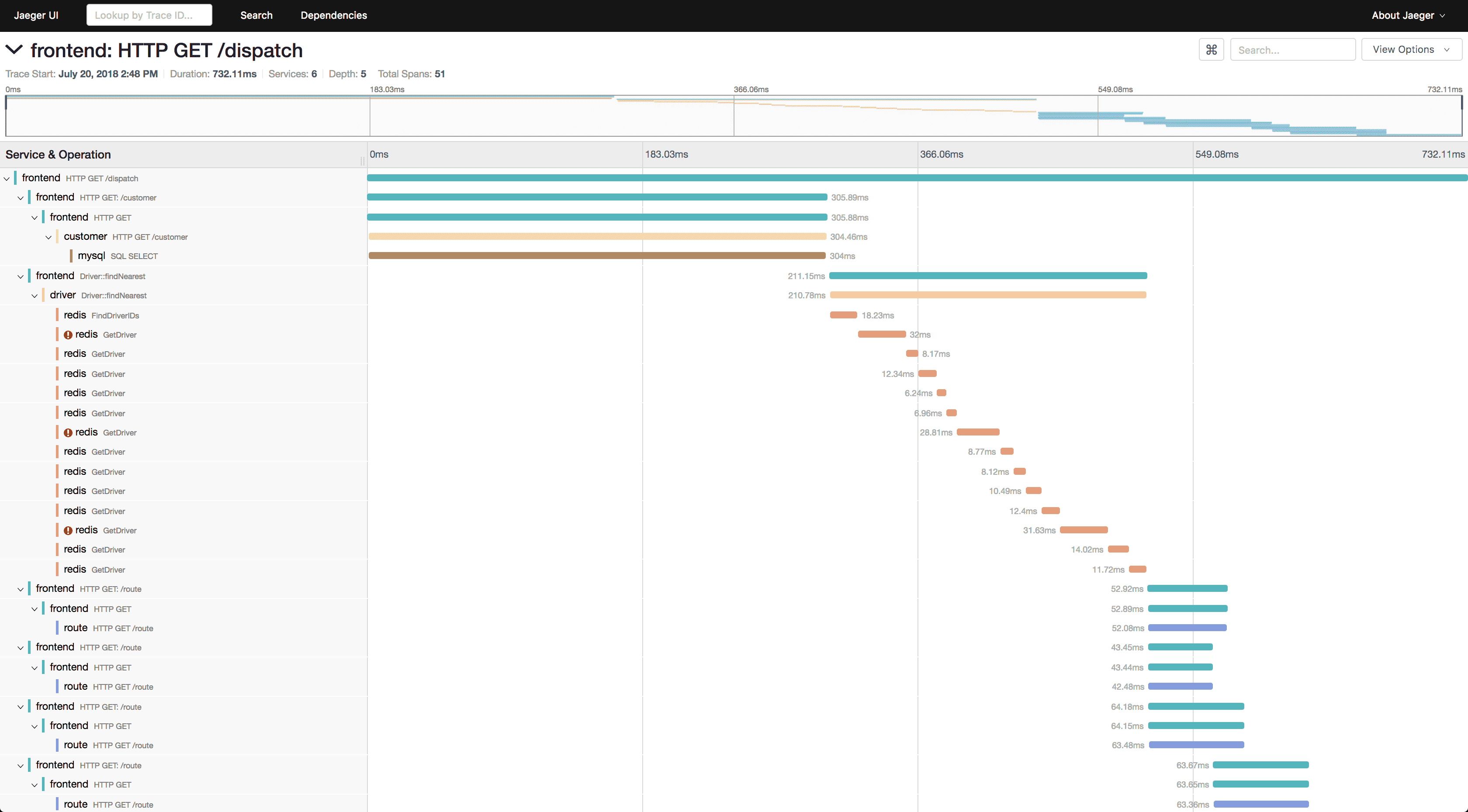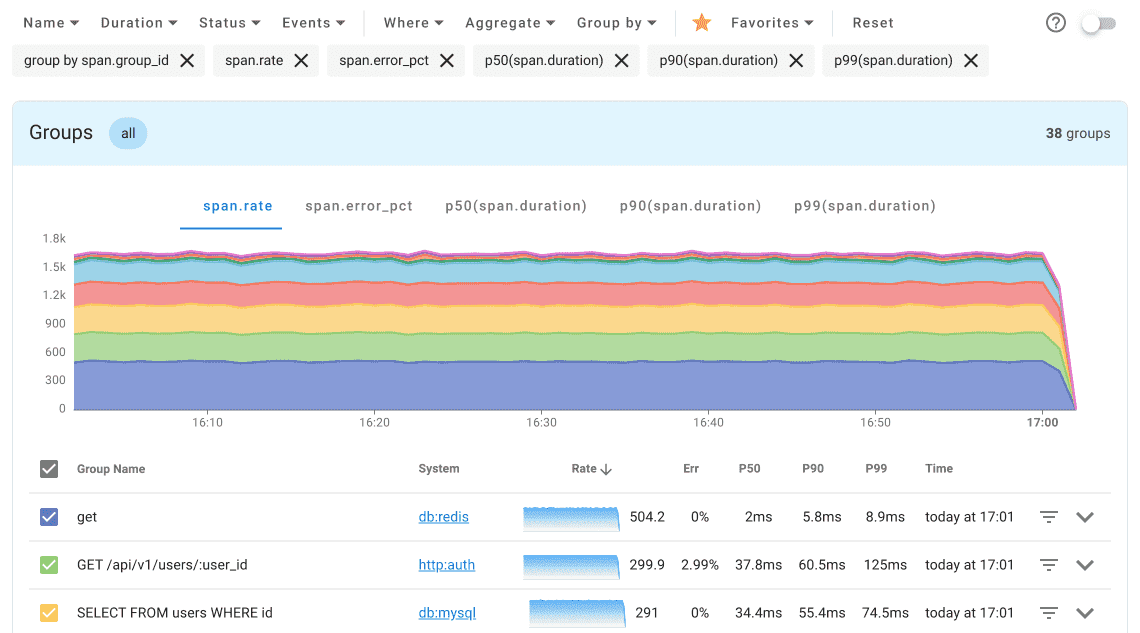Jaeger vs OpenTelemetry [2025 comparison]
OpenTelemetry and Jaeger are both tools used for observability and tracing in distributed systems.
Jaeger is a project within OpenTelemetry ecosystem that is often used as the default OpenTelemetry backend for storing, analyzing, and visualizing telemetry data. So, how do they compare?
What is Jaeger?
Jaeger is an end-to-end distributed tracing tool that helps developers monitor and troubleshoot complex, microservices-based architectures.

Jaeger provides instrumentation libraries for various programming languages, allowing you to capture and trace requests as they flow through different services.
Jaeger plays a crucial role in distributed systems monitoring, providing insights into the performance, latency, and dependencies of individual components within a complex microservices architecture.
Jaeger also provides an easy-to-use web interface for searching and visualizing trace data, which can be especially helpful for developers to optimize the performance of their applications.
What is OpenTelemetry?
OpenTelemetry is an observability framework that aims to provide a standardized way to instrument and collect telemetry data from applications and systems.
OpenTelemetry encompasses distributed tracing, metrics, and logging, allowing you to gather rich telemetry data to understand the behavior and performance of your applications.
OpenTelemetry provides a set of APIs and SDKs for various languages, making it easier to instrument your code and send telemetry data to backend systems.
Jaeger vs OpenTelemetry
Jaeger and OpenTelemetry are complementary technologies. Jaeger is a specialized distributed tracing system, while OpenTelemetry is a broader observability framework that includes tracing, metrics, and logging.
So, while Jaeger focuses specifically on distributed tracing, OpenTelemetry provides a more comprehensive approach to observability by including tracing, metrics, and logging.
You can use Jaeger as the default OpenTelemetry backend when using OpenTelemetry to gather telemetry data from your applications.
Why use Jaeger?
Jaeger is particularly useful if you are developing or operating a system based on microservices architecture, Jaeger can provide valuable insights into the interactions and dependencies between the services. It allows you to trace requests as they flow through the different services, providing a holistic view of the system's behavior and performance.
Jaeger has strong integration capabilities with various frameworks, libraries, and platforms. It provides instrumentation libraries for popular programming languages and integrates well with other observability tools and frameworks.
Jaeger is most suitable in scenarios where you need detailed visibility into the behavior and performance of distributed systems, microservices architectures, and complex service interactions. It excels in helping you optimize performance, troubleshoot issues, and gain insights into the flow of requests through your system.
Why use OpenTelemetry?
OpenTelemetry is designed to be vendor-agnostic and platform-independent. It supports various cloud providers, third-party observability tools, and on-premises environments. This flexibility allows you to use OpenTelemetry with your preferred cloud platforms or on your own infrastructure without being locked into a specific vendor's observability solution.
OpenTelemetry offers standardization, comprehensive observability, vendor-agnostic and multi-cloud support, flexibility and extensibility, open-source collaboration, and future-proofing benefits.
What is the alternative to Jaeger and OpenTelemetry?
OpenTelemetry provides flexibility in choosing the backend for storing and analyzing trace data. While Jaeger is a popular choice, OpenTelemetry allows you to use different tracing backends based on your needs and preferences. For a comprehensive comparison of available options, see our guide to distributed tracing tools.
Uptrace is an OpenTelemetry APM that helps developers pinpoint failures and find performance bottlenecks. Uptrace can process billions of spans on a single server and allows to monitor your software at 10x lower cost.
Uptrace is fully compatible with OpenTelemetry and natively supports OpenTelemetry protocol (OTLP) either via gRPC or HTTP transports.

The choice of backend depends on your specific requirements, existing infrastructure, and preference for a particular platform or service provider. OpenTelemetry's flexibility allows you to switch between different tracing backends based on your needs or even use multiple backends simultaneously for different parts of your application stack.
Summary
OpenTelemetry has a modular architecture that allows you to choose the components you need. You can use Jaeger or Uptrace as the backend for collecting and storing trace data when working with OpenTelemetry.
FAQ
- What is the main difference between Jaeger and OpenTelemetry? Jaeger is specifically focused on distributed tracing, while OpenTelemetry is a comprehensive observability framework that includes tracing, metrics, and logging capabilities. Jaeger can actually serve as a backend for OpenTelemetry.
- Can I use Jaeger and OpenTelemetry together? Yes, they work together seamlessly. OpenTelemetry can send telemetry data to Jaeger, which acts as a backend for storing, analyzing, and visualizing the collected data. This is actually a common deployment pattern.
- Which one should I choose for my project? The choice depends on your needs. Choose OpenTelemetry if you want a comprehensive, vendor-neutral observability solution. Choose Jaeger if you specifically need distributed tracing capabilities and prefer its visualization interface. Many organizations use both together.
- How does Jaeger fit into the OpenTelemetry ecosystem? Jaeger serves as one of the default backend options for OpenTelemetry. It can receive and store telemetry data collected by OpenTelemetry, and provides tools for visualizing and analyzing this data through its web interface.
- What are the key advantages of using OpenTelemetry? OpenTelemetry offers vendor neutrality, standardization across different platforms and languages, comprehensive observability (traces, metrics, and logs), and future-proof instrumentation. It also provides flexibility in choosing different backends.
- Is Jaeger still relevant with OpenTelemetry's rise? Yes, Jaeger remains highly relevant as a specialized tracing system and popular backend choice for OpenTelemetry. Its strengths in distributed tracing visualization and analysis make it a valuable tool, especially in microservices architectures.
- Are there alternatives to both tools? Yes, platforms like Uptrace offer integrated solutions that are compatible with OpenTelemetry while providing their own enhanced features. Uptrace can process billions of spans on a single server and offers cost-effective monitoring solutions.
- How do they handle scalability in production? Both tools are designed for production use. Jaeger provides robust scalability for tracing data, while OpenTelemetry's modular architecture allows it to scale based on your needs. The scalability often depends more on the chosen backend implementation.
You may also be interested in: